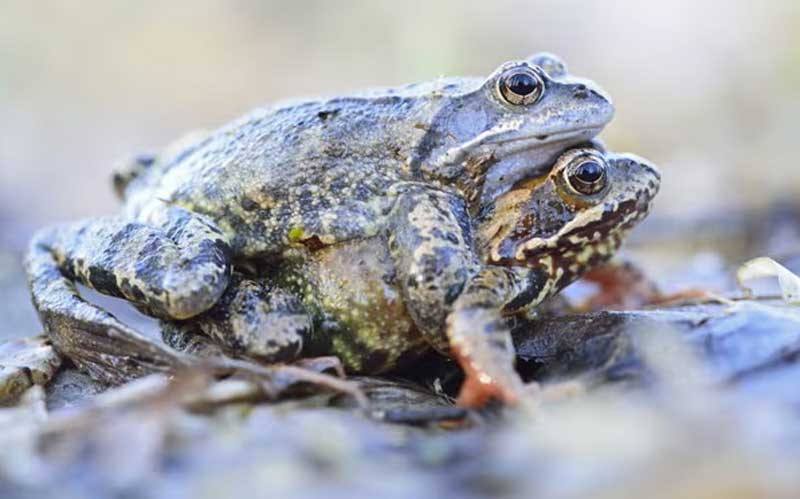
When it comes to avoiding unwanted male attention, researchers have found some frogs take drastic action: they appear to feign death.
Researchers say the findings shed new light on the European common frog, suggesting females do not simply put up with the male scramble for mates – a situation in which several males can end up clinging to a female, sometimes fatally.
“It was previously thought that females were unable to choose or defend themselves against this male coercion,” said Dr Carolin Dittrich, the first author of the study from the Natural History Museum of Berlin.
But the research suggests this may not be the case. “Females in these dense breeding aggregations are not passive as previously thought,” Dittrich said.
Writing in the journal Royal Society Open Science, Dittrich and her co-author, Dr Mark-Oliver Rödel, report how they placed each male frog in a box with two females: one large and one small. The mating behaviour was then recorded on video.
The results, obtained from 54 females who experienced the clutches of a male, revealed that 83% of females gripped by a male tried rotating their body.
Release calls such as grunts and squeaks were emitted by 48% of clasped females – all of whom also rotated their body.
Tonic immobility – stiffening with arms and legs outstretched in a pose reminiscent of playing dead – occurred in 33% of all females clasped by a male, with the team adding it tended to occur alongside rotating and calling.
- Sapien Sapien: Traces of colonialism on full display
- 900K left for diaspora in 2020-21: Govt
- Huawei dominates MWC mobile tech fair despite US sanctions
- IYASA, Theatre Strahl in climate change play
Keep Reading
Smaller females, they note, more frequently employed all three tactics together than larger ones.
While unusual, tonic immobility – it turned out – had been seen before. “I found a book written in 1758 by Rösel von Rosenhoff describing this behaviour, which was never mentioned again,” Dittrich said.
The team says tonic immobility could be a stress response. They found this was more common in smaller and therefore younger females, which could be a result of greater stress arising with less experience of reproduction.
The three tactics, they add, allowed at least some females to evade the clutches of the males. “Displaying of mate avoidance behaviour resulted in the escape of 25 females.”
However, the researchers acknowledge the behaviours may have other purposes, suggesting that while female rotations may help them dislodge a male, it could be a way to test the male’s strength and endurance – traits that could boost their survival chances if the male can fend off rivals and prevent a “mating ball”.
The study also has limitations, including that a larger sample size is needed to investigate whether smaller females are indeed more successful at escaping, as the research hints, and that only one male was presented to each pair of females.
“In the real world we often observe the formation of mating balls, but also that females can more easily dive away because there is more structure and places to hide,” Dittrich said, adding that while the tactics identified could be successful in nature as well, it was not clear to what degree.
However, Dittrich noted the study gave fresh insight on the behaviour of the females. “I think even if we call this species a common frog and think we know it well, there are still aspects we don’t know and perhaps haven’t thought about,” she said.







